
Dan Freeland
01.19.2021
Colorizing the Journey of the Lubricant
If you look up bearing failures, you are bound to get a variety of different results. But, what is consistent is that there is always a wedge of the pie chart that relates to improper lubrication. What it means specifically for each result may vary, but the title includes cross-contamination of lubricants and/or using the wrong lubricants all together. This wedge is typically responsible for 20-35% of all bearing failures, sometimes more.
Trico’s Spectrum line of products were developed to be a Visual Lubrication Management tool that uses color coding to ensure the correct lubricant is used in the right piece of equipment and in the proper location. It also greatly reduces the chance of cross-contamination of lubricants. Combine Spectrum Oil Containers with other Spectrum products for effective lubrication management from arrival to point of use.
This article will follow the Journey of the Lubricant® to identify color coding opportunities at each stage of the journey.
Note: Incorporating shapes and/or numbers to the color-coded system is an effective way to incorporate those who cannot distinguish between different colors.
Arrival
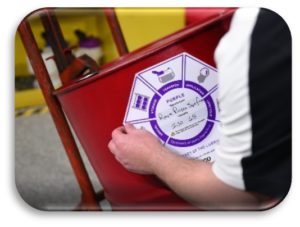 Arguably the most important for stage for oil identification because the transfer of the chain of custody that id’s that oil is going from vendor now to customer. Incoming lubricants should be tested to verify vendor paperwork, then identified and labeled with the customers proper color designation. It doesn’t matter if it is a tube of grease or it is a 250-gallon tote of oil. Receiving SOP’s need to identify the labeling system to be used, as they may differ for different size containers. They need to also include the color designation for each lubricant. Proper labeling provides receiving and inventory personnel an indication of where the lubricant is to be stored when it is put into inventory. This is assuming the storage area is set up properly.
Arguably the most important for stage for oil identification because the transfer of the chain of custody that id’s that oil is going from vendor now to customer. Incoming lubricants should be tested to verify vendor paperwork, then identified and labeled with the customers proper color designation. It doesn’t matter if it is a tube of grease or it is a 250-gallon tote of oil. Receiving SOP’s need to identify the labeling system to be used, as they may differ for different size containers. They need to also include the color designation for each lubricant. Proper labeling provides receiving and inventory personnel an indication of where the lubricant is to be stored when it is put into inventory. This is assuming the storage area is set up properly.
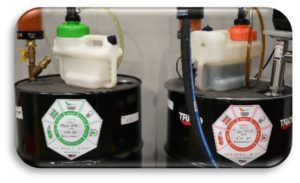 Storage
Storage
Storage areas for different lubricants need to be well defined with colored floor tape, paint and wall charts that define what color each lubricant is assigned to and where it is located in the lube storage area. Whether it is grease or oil, color assignments should be crystal clear. Dispensing filtration systems and dispensing pumps for pails, drums, or totes should also incorporate the color assignment of the lubricant. Portable filtration systems should be stored similar to stored lubricants with clearly defined areas for each dedicated portable filtration system.
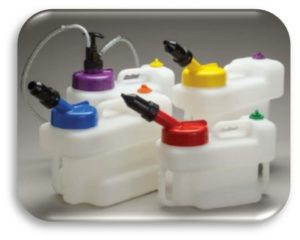 Transfer
Transfer
Secondary containers should be either labeled or tagged with the same color-coded designation for that fluid or grease. For oil, Trico Spectrum Container lids and breather vents come in 10 different colors, covering up to 100 different color combinations if necessary, but 10 or less color combinations are usually sufficient. Transfer carts should be painted or labeled for lubricant identification.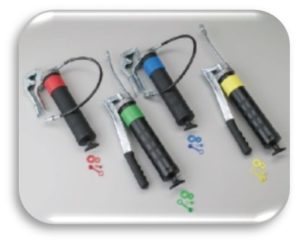
As for grease lubrication, grease guns should be either clear, color anodized, or use color coded rubber bands to color the grease gun with the corresponding identification color.
Secondary containers and grease guns need to be dedicated to the lubricant and color they are assigned to from the beginning until the end of use. This will help to reduce the chance of cross contamination.
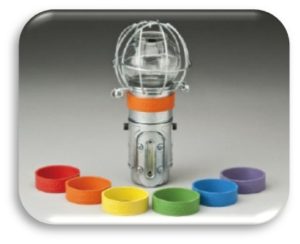 Application
Application
Equipment lubrication points, fill ports, and sampling devices all should be color identified and coordinated to identify what lubricant is going in, or coming out of that port. Colored grease zerk caps, grease fitting washers, and colored identification tags should be used at each lubrication related point. Constant level oilers and single point grease lubricators can use the identification tags and or bands to make it abundantly clear what lubricant belongs there.
Lifecycle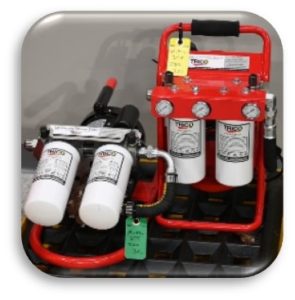
If filtration systems are a component of your lube program to extend lubricant life while in use, ideally, they should be dedicated to one lubricant. The filtration system should follow the same color-coding identification system by using paint, tags or labels.
Colorizing the Journey of the Lubricant
If you are looking to start a quality lubrication program, or add to an existing program, incorporate a color-coding identification system. Adding color coding to your lubrication program is one of the easiest, most cost-effective ways to prevent adding the wrong lubrication to your equipment and also prevents cross contamination.
To learn more, watch the below video that takes you through incorporating the Spectrum Color-Coding System into each stage of the Journey of the Lubricant.







